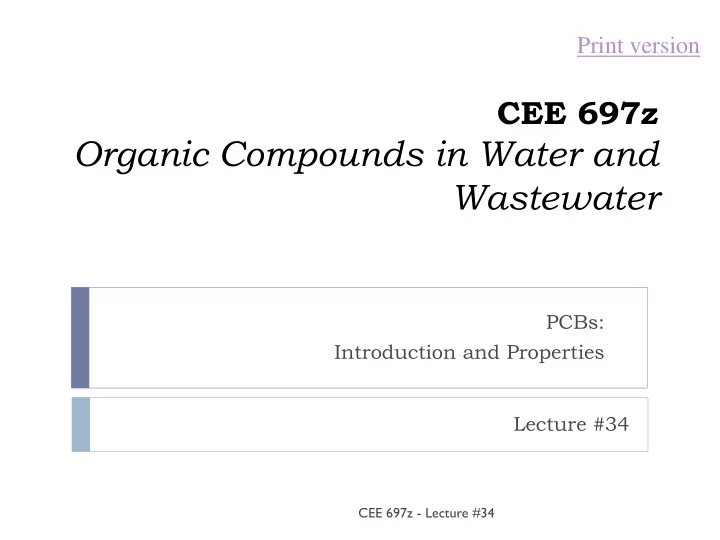

Print version CEE 697z Organic Compounds in Water and Wastewater PCBs: Introduction and Properties Lecture #34 CEE 697z - Lecture #34
PCBs in the Lake Superior Reference: Jeremiason, Hornbuckle and Eisenreich, Environmental Science and T echnology, 28:903 (1994) St. Mary’s River CEE 697z - Lecture #34
Empirical Models ( ) = ∑ ∑ − 0 20 . t PCB PCB e 25 25 o ( ) = ∑ ∑ − 0 22 . t PCB PCB e 82 82 o Data tell us that about 26,500 kg has been lost from the water column between 1980 and 1992 CEE 697z - Lecture #34
Loss rates depend on specific congener Log Kow -0.6 -0.5 -0.4 k (/yr) k (yr-1) -0.3 k-regr. -0.2 Good correlation -0.1 with K ow 0 4.5 5 5.5 6 6.5 7 7.5 CEE 697z - Lecture #34
' ≡ dissolved toxicant c d Sorption c p ≡ particulate toxicant = φ and: c ' c d d Definitions = + so: c c c T p d m k u Particle K dissolved to particulate equilibrium ← → ' c c d p CEE 697z - Lecture #34
Langmuir Isotherm At Equilibrium Rate of adsorption = rate of desorption = R R ad de ( ) ν − ν = ν k M c k M So, solving for the sorbed concentration ( ν ) ad s d m de s = ν c ν m d de + k c d k ad CEE 697z - Lecture #34
Limiting Cases When C d is small, and there are lots of surface sites Common situation for trace “toxics” like PCBs ν ν ν c c k ν = ≈ = m d m d m ad c + d k k c k de de k d k de ad ad ν = K d c d So the bulk particulate concentration is: = ν = c m mK c p d d And the total toxicant is: = + = + c c c c mK c T d p d d d CEE 697z - Lecture #34
Toxics: Linear sorption modeling Now define c c ≡ = d d f + d c c mK c T d d d adsorption model K m 1 = 1 = 1 d f f + + p d m m K K d d c = + = c = f c f f 1 f c d d T p p T d p CEE 697z - Lecture #34
1 = 1 f Estimation of partition coefficients + d K m d Relationship to organic fraction − mg tox . K = − 3 m f K g C or − − mg tox . d oc oc g C 3 m and properties of organic fraction Octanol:water partition − = 7 K 6 . 17 x 10 K coefficient oc ow combining, we get: − − = mg tox . 7 K 6 . 17 x 10 f K − 3 m Oct . d oc ow − . mg tox − 3 m H O 2 Karickhoff et al., 1979; Wat. Res. 13:241 CEE 697z - Lecture #34
Octanol:water partitioning 2 liquid phases in a separatory funnel that don’t mix octanol water Add contaminant to flask Shake and allow contaminant to reach equilibrium between the two Measure concentration in each (K ow is the ratio) CEE 697z - Lecture #34
Observations Summary of K ow and TSS effects From Chapra, pg. 722 CEE 697z - Lecture #34
Box and Whisker Plots Useful for summarizing non-ideal data distributions Thickness is proportional to the square root of the number of outlier observations x Median Upper data range Lower data range Upper quartile Lower quartile CEE 697z - Lecture #34
To next lecture CEE 697z - Lecture #34
Recommend
More recommend